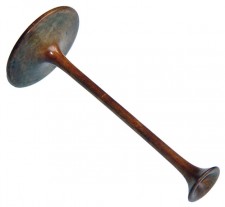 In 1816 the ubiquitous stethoscope, in modern times a symbol of medicine itself, made its first appearance.
In 1816 the ubiquitous stethoscope, in modern times a symbol of medicine itself, made its first appearance.
With it came a higher order of clinical assessment; far better diagnosis than had been possible before. But to the public it was more than that. A stethoscope, and a doctor who could diagnose a problem by listening, was comforting -- being able to find a problem by listening spoke of years of experience and insight, all devoted to personal medical problems.
The stethoscope can't take credit for all of the wonderful advancements in medicine we have enjoyed during its existence, but it can take credit for why medicine became such a personal thing: having your head eight inches from someone's chest, in the interest of protecting their health, is inherently intimate, without being intrusive.
Stethoscope is derived from the Greek stethos (chest) and skopos (observer) and the term couldn't be more accurate; that is what it does, by letting a physician listen for irregularities. Decades after its invention, when Charles Goodyear patented modern vulcanization of rubber, the stethoscope got its signature look, with ear buds and a bell on the end, a look that has remained to this day. A stethoscope and a combustion engine are 19th-century inventions that haven't been surpassed for value in the 21st.
One hundred and ninety nine years later, the stethoscope is not yet extinct when it comes to medical diagnosis, but modern technology in the form of ultrasound devices has surely put it on the path to being a quaint artifact.To hear bowel sounds and for pulmonary issues, there is nothing more cost effective. But medicine rarely uses symptom-based diagnosis anymore and so the hallmark of two centuries of modern medicine is gradually becoming more of a prop than a tool.
Here at the office of the American Council on Science and Health, Dr. Gilbert Ross, our Senior Director of Medicine and Public Health, carries one in his computer bag. When I was discussing this article with him, he took it out to show me. "When is that going to be used?" I wondered. "If someone has a heart attack on the subway a guy who has been practicing medicine for 35 years does not need to listen to his heartbeat.
But it is part of medical culture, he would no sooner leave the house without it than leave without his arm -- or at least it used to be. We don't do symptom-based medicine much in 2015, and in the past I have expressed concern about a 'teach to the protocol' environment in medical schools, especially in a world of more government control over health and with defensive medicine the norm. In the near future, there won't be room for a Dr. House assuring residents it's not Lupus; they will have to go ahead and test for Lupus.
Medicine is becoming less personal, even as we converge on personalized medicine. In a letter to the New York Times, Stephen Bergman, professor of medicine at N.Y.U., notes that modern interns spend 80 percent of their time in front of a computer screen -- they don't even draw blood any more.
That lack of personal contact -- the loss of the stethoscope in ways beyond a tool -- may be why 66 percent of doctors now recommend that someone who really wants to help people in a personal way should become nurse practitioners instead.
Hank Campbell is the President of the American Council on Science and Health. He can also be reached on Facebook, Twitter and Science 2.0. Top image: Monaural stethoscope by Down, London. Link: Alex Peck Medical And Surgical Antiques Archives



